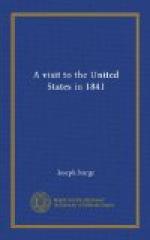I finally quitted this city, in the steamer, for Boston, on the 24th, accompanied by John G. Whittier.
I remained in Boston till the first of the Eighth Month, (August) when I embarked on board the “Caledonia” steamer for England.—During the interval, I made a number of calls upon the abolitionists in Boston; and, among others, saw Henry and Maria Chapman and Wendell Phillips; the former of whom had just returned from a visit to Hayti, and the latter from Europe. I had several interviews with Martha V. and Lucy M. Ball, secretaries of the Boston Female Emancipation Society, who have long been faithful and laborious abolitionists. I also met, as at New York, a number of the friends of the cause, again to consider the best time for calling a second general Convention, to whom I read the London minutes on that subject. A resolution was unanimously passed, of the same tenor as those of New York, lately noticed. While in this city, I had not only the pleasure of renewing my intimacy with my friend, Nathaniel Colver, who is known to many of the English abolitionists as their valuable and cordial coadjutor at the great Convention in London, but of becoming acquainted with many zealous and able friends of the slave. One of these was Amos A. Phelps, one of those who signed the original declaration issued by the American Anti-Slavery Society, on its foundation at Philadelphia, in 1833.
We also went to Salem, and met a number of “Friends” who were abolitionists, and who appeared desirous to embrace every suitable opportunity of promoting the cause.
Salem is a city of about fourteen thousand inhabitants, and I was told that the number of its population who went and returned to and from Boston, a distance of fourteen miles, weekly, was about five hundred—a striking proof of the locomotive energy of the Americans. Their gratification, in this respect, has been much facilitated of late by the rapid extension of railways. These, with few exceptions, are by no means so completely




